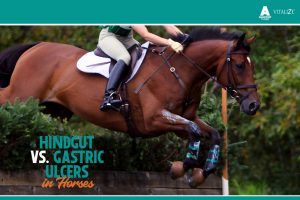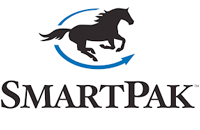GASTRIC ULCERS
WHAT TO LOOK OUT FOR
Warning Signs
Grumpy
Frequent Colic
Sensitive to the Touch
Girthy/Cinchy
Lack of Appetite
Weight Loss
Behavioral Issues
Poor Coat
Decrease in Performance
Risk Factors
High Perfromance/Stress
High Starch Meals
Minimal Forage
6+ Hours in Between Feedings
Traveling
Decreased Turnout
Changes in Routine
A Guide to Avoiding Ulcers in Horses
![]()
Appropriate Diet
Provide low-starch, high forage meals.
![]()
Consistent Schedule
Feed 3-4 meals in a day to reduce the amount of starch per meal and decrease the amount of time the stomach is left empty.

Decrease Stress
Provide regular turnout and exercise while at competition and reduce any anxieties in their daily life.
![]()
Preventative Supplement
Feed a research-proven supplement, like Vitalize Alimend, to help prevent ulcers and soothe the stomach lining.


Vitalize® Alimend®
Provides 24/7 stomach comfort and relieves equine gastric issues commonly associated with training, traveling, and performance without altering stomach pH or hindering digestion.
- Vitalize® Alimend® is a unique blend of: MHB3® Hyaluronan, H. erinaceous (Lion’s mane) extract, and AO-Biotics®
- A natural product that helps heal and protect without altering stomach pH.
- Safe for routine and continuous use in all types of horses.
What Our Customers Are Saying
 Ian Miller
Ian MillerMillar Brooke Farm
10-time Olympic Show-Jumper
Vitalize® Alimend® is the real deal. We started with it because one of my daughter’s horses had chronic stomach issues and we got a dramatic result. It is the complete package for gastrointestinal digestive health, and a product like Alimend can go a long way helping you and your horse stay healthy and comfortable."
Learn More About Combating Ulcers

Hindgut vs Gastric Ulcers: Do you know the difference?
- Did you know? Horses with gastric ulcers often develop hindgut ulcers, too!
- Gastric ulcers are lesions on the horse's stomach lining and are the most common type of ulcer in the horse.
- Hindgut or colonic ulcers are lesions located further down the digestive tract in the intestines or "colon" of the horse.

A Comprehensive Guide to Equine Gastric Health
Gastric health is achieved when the stomach is free of disease and discomfort. Unfortunately, in performance horses the incidence of gastric discomfort is high. The horse’s stomach continuously secretes hydrochloric acid throughout the day and night, regardless if feed has been ingested. High acid in the stomach, especially in an empty stomach, predisposes the horse […]
Read More

Strategically Feeding the Ulcer-Prone Horse
What does an ulcer-prone horse look like? The first thing that comes to mind is the racehorse. He or she is young, travels often, runs its heart out and is fed massive amounts of feed in one day from the very beginning. This assumption is correct, since racehorses have the highest rate of ulcers at […]
Read More

Olympic Show-Jumper is Dedicated to the Sport of Equine Business
Life is about choices. For one business school graduate, the choice was simple. She preferred returning to the family business of long days, weeks away from home and working with equine clients over the hustle and bustle of corporate life behind a desk. “The best part of my job is the pleasure to work with […]
Read More







